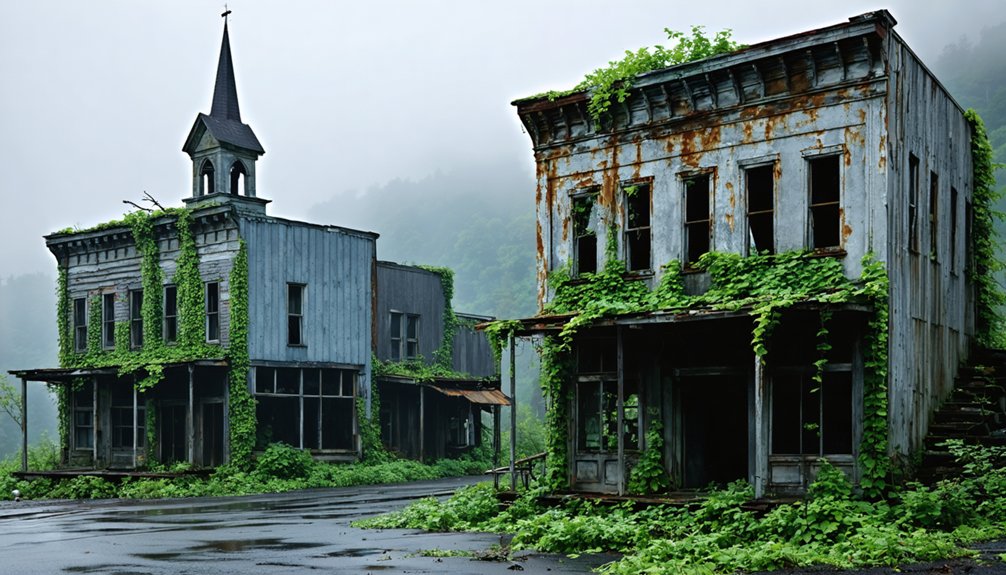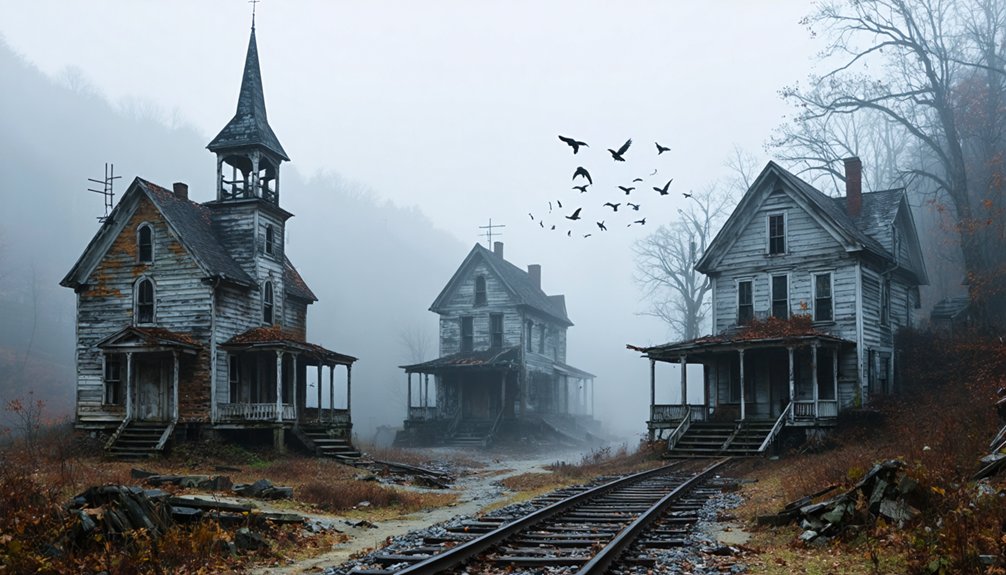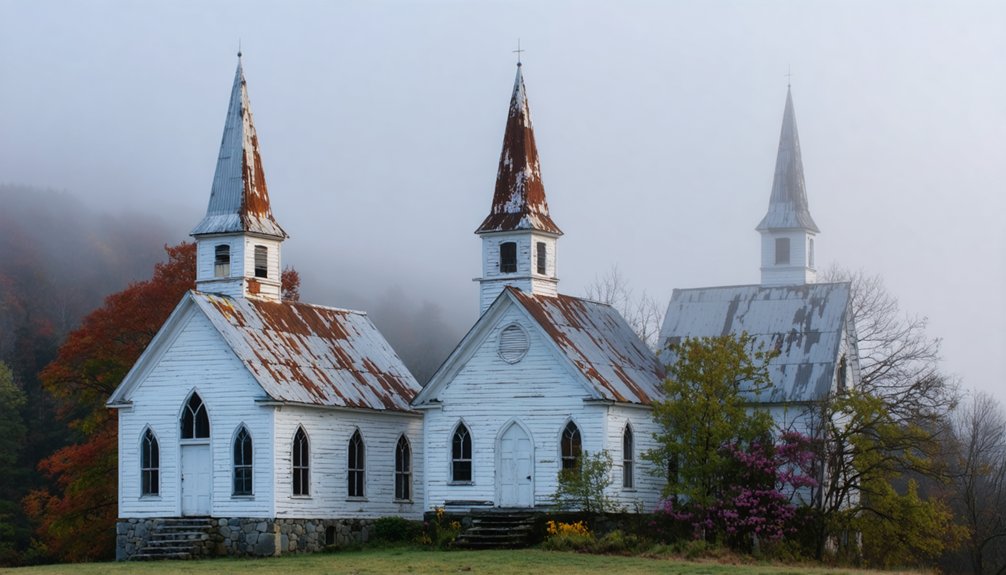Three forgotten Appalachian ghost towns offer unique historical glimpses: Lost Cove, the moonshiner’s paradise straddling the NC-TN border that thrived until 1957; Thurmond, a coal boom town that generated massive railway revenue before decline; and Loyston, a community submerged beneath Norris Lake during 1930s dam construction. Each town represents distinct aspects of Appalachian heritage—from moonshine culture to industrial prosperity to infrastructure sacrifices. The stories behind these abandoned settlements reveal America’s complex mountain history.
Key Takeaways
- Lost Cove straddled the North Carolina-Tennessee border and thrived on moonshine production until its abandonment in 1957.
- Thurmond became the highest revenue-generating station for C&O Railway during the coal boom of the early 1900s.
- Loyston was completely submerged in 1936 during the construction of Norris Dam, with remnants visible during drought periods.
- These ghost towns showcase distinct aspects of Appalachian history: moonshine culture, coal industry, and infrastructure development impacts.
- Preservation efforts by organizations like the National Park Service maintain these sites as windows into Appalachian heritage.
Lost Cove: The Moonshiner’s Paradise Between State Lines
Nestled within the remote Nolichucky Gorge region of Pisgah National Forest, Lost Cove emerged during the Civil War era as a distinctive settlement straddling the border between North Carolina and Tennessee.
History reveals itself in forgotten places, where the wild meets the willful spirit of those who sought refuge between borders.
For nearly 60 years, this unclaimed territory flourished as residents capitalized on jurisdictional ambiguity to develop a thriving moonshine culture.
You’d find a self-sufficient community here, with families maintaining their agricultural heritage through farming while supplementing income through timber work after the railroad’s arrival in 1910.
The strategic location between state lines hindered tax collection and law enforcement, creating a haven for moonshiners as early as 1898.
This blend of isolation, self-reliance, and defiance of authority defined Lost Cove until its eventual abandonment by 1957, when the economic limitations of its remote setting finally outweighed the freedoms it afforded.
The community’s resilience was evident in its structures, including a local schoolhouse that doubled as a church for the isolated residents.
Today, the area stands protected by the Southern Appalachian Highlands Conservancy, which purchased the land in December 2012 with aims to preserve its historical significance and natural beauty for future generations.
Thurmond: The Coal Boom Town Frozen in Time
Unlike many boom-and-bust Appalachian settlements, Thurmond stands as a remarkably preserved monument to America’s coal and railroad golden age. Founded around 1900 by Captain William D. Thurmond, this strategic New River Gorge location quickly became the C&O Railway‘s highest revenue-generating station, shipping over 4 million tons of coal annually by 1910. The town’s notoriously lawless atmosphere led a local pastor to remark that the “only difference” between Hell and Thurmond was the river running through it.
You’ll find Thurmond’s distinctive architecture largely intact—from the Hotel Thurmond to banking facilities once among West Virginia’s wealthiest. The town’s unique railway-centered layout reflects its inaccessibility by road until well into the 20th century.
The Thurmond railway infrastructure, including the 1922 concrete coaling tower, supported up to 15 daily trains and employed nearly 200 men during peak operations. The historic depot now serves as a visitor center where tourists can learn about the town’s significant past.
Now preserved by the National Park Service, this ghost town offers a frozen-in-time glimpse of America’s industrial past.
Loyston: The Submerged Community Beneath Norris Lake
While Thurmond’s structures remain visible monuments to Appalachia’s industrial past, another ghost town exists only in memories and occasional drought-revealed glimpses.
Loyston, Tennessee, established in the 1800s along State Highway 61, now rests beneath Norris Lake.
When the TVA built Norris Dam in the 1930s during the Great Depression, they submerged this entire community under 60 to 90 feet of water.
You’ll find this submerged history near today’s Big Ridge State Park in what’s called the Loyston Sea. During severe droughts, stone foundations and old roadbeds emerge from the receding waters, offering rare windows into the community legacy.
The town’s residents, many with generational roots, were displaced and formed New Loyston nearby.
Their sacrifice—documented through photographs and TVA surveys—represents the price of Depression-era progress. Before its submersion, Loyston was a thriving community with approximately 70 residents, a post office, school, churches, and various small businesses.
The town was named after John Loy, a prominent local businessman, in 1894 before its complete flooding in 1936.
Frequently Asked Questions
Can Visitors Safely Explore These Ghost Towns Without Permits?
No, you can’t explore most ghost towns without permits. You’ll need to follow safety regulations while respecting their historical significance. National Park sites allow access, but private properties require explicit permission.
What Supernatural Legends Are Associated With Appalachian Ghost Towns?
Over 70% of Appalachian ghost towns harbor supernatural legends. You’ll encounter tales of haunted history throughout these settlements, from spectral sightings of miners in abandoned tunnels to whispers of vanished residents along forgotten pathways.
When Is the Best Season to Photograph Appalachian Ghost Towns?
Fall offers ideal conditions with autumn hues framing decayed structures, while spring blooms create striking contrasts. You’ll find both seasons provide mild temperatures and photographic drama without summer’s humidity or winter’s access challenges.
Do Any Descendants of Original Residents Conduct Tours?
Absolutely everywhere you turn, descendants conduct tours! You’ll encounter richly detailed descendant stories during tour experiences, offering authentically transmitted familial histories through reenactments, storytelling, and annual commemorative gatherings at former settlements.
How Have Climate Change and Weather Affected Ghost Town Preservation?
You’ll find climate impact manifests through intensified flooding, temperature extremes, vegetation encroachment, and extreme weather events—all creating multifaceted preservation challenges for these fragile historical structures you’re free to explore.
References
- https://appalachian.org/lost-cove-ghost-town-in-the-national-forest/
- https://appalachianmemories.org/2025/10/16/the-lost-towns-of-appalachia-the-forgotten-mountain-communities/
- https://www.youtube.com/watch?v=NFkORhmPfg0
- https://www.thewanderingappalachian.com/post/the-underwater-towns-of-appalachia
- https://www.youtube.com/watch?v=CtA93ACBHXs
- https://www.youtube.com/watch?v=4oHlJFXbrCk
- https://www.touristsecrets.com/travel-guide/weird-amazing/the-untold-history-of-the-appalachian-ghost-towns/
- https://www.blueridgeoutdoors.com/go-outside/southern-ghost-towns/
- https://www.youtube.com/watch?v=hKXyVRX0FQM
- https://www.youtube.com/watch?v=3F_Gv_xp3Y4



